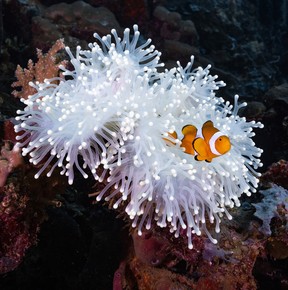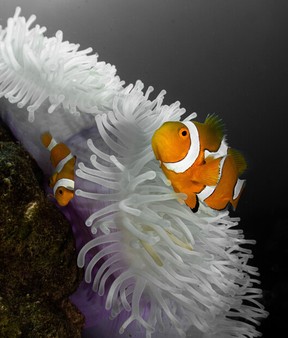SHRINKING NEMO: How clownfish survive deadly marine heat waves

Article content
If you’ve ever watched “Finding Nemo,” you know clownfish face many ocean threats: hungry sharks, ravenous seagulls, eager scuba divers that may scoop them up and put them into a dental office aquarium.
Left unmentioned in the Disney-Pixar film is perhaps the biggest threat Nemo and his little orange-and-white cousins face: climate change, which is devastating their delicate reef habitats.
Now, a new study spotlights one strange behaviour that appears to be helping orange clownfish, also called anemonefish, to survive in warmer waters. Clownfish have been shown to shrink their bodies during what otherwise would be deadly marine heat waves.
“They have these amazing abilities that we still don’t know all that much about,” said Theresa Rueger, a tropical marine ecologist who helped conduct the research, published in the journal Science Advances on Wednesday. “So there’s potential that maybe some other species will adapt in a way that will allow them to hang on longer than we think.”
Across Earth’s oceans, fish species of all shapes and sizes are getting smaller, with potentially dire implications for the billions of people who rely on seafood for protein. Scientists say the change may result from a combination of overfishing and climate change. Commercial and recreational fishing operations are plucking up the biggest fish. Meanwhile, the ripple effects of higher ocean temperatures may be making it harder for creatures to find food and take in enough oxygen.
The new study, though, suggests that size observations may reflect something beyond overfishing and stunted growth.
“Until now, when talking about shrinking fish, nearly all studies do not mean that fish literally shrink but that they grow to smaller sizes,” said Asta Audzijonyte, a senior lecturer at the University of Tasmania in Australia who was not involved in the research. “This study, in contrast, reports observations of anemonefish actually shrinking by a few percent of their total length over the course of a month.”

When Rueger, from Britain’s Newcastle University, and her research team started observing clownfish in Papua New Guinea’s Kimbe Bay, they intended to study the effects of freshwater runoff. But that year, 2023, the waters there reached a “proper hot bath temperature,” Rueger said, as the world went through a massive coral-bleaching event that wreaked havoc across reef ecosystems in the Atlantic, Pacific and Indian oceans.
“It was heartbreaking to watch the heat wave unfold, given that these anemonefish have no option but to endure it,” said Melissa Versteeg, a doctoral student from Newcastle who led the study. “I also recognized how unique my position was, in that I would be able to document its impacts.”
Once a month during the course of the heat wave, the researchers carefully captured the same 67 breeding pairs of the species Amphiprion percula with aquarium nets and measured their lengths with calipers.
Clownfish are “pretty easy to catch,” Rueger said. “The whole procedure maybe takes 20 to 30 seconds, if you’re good at it, for each fish. They usually don’t know what happened to them.”
Every four to six days, the team also took the temperature of each pair’s sea anemone – the vibrant, spaghetti-shaped animal that clownfish call home. Mating pairs of clownfish help feed and clean the sedentary sea anemone, while the anemone shoos away predators with its venomous tentacles. When a female clownfish dies, a male is able to switch sexes. (Yes, this means that in a more scientifically accurate version of “Finding Nemo,” Nemo’s dad, Marlin, may have become a mom.)
Between February and August, nearly three-fourths of the adult clownfish decreased in length at least once between monthly check-ins, according to the study. The fish that shrank alongside their breeding partners had a higher chance of surviving the heat wave.
Audzijonyte, of the University of Tasmania, said the study was “very well executed,” and “its data and analyses appear to be very solid.”

Joshua Lonthair, a lecturer at the University of Massachusetts at Amherst who also studies fish size, said the research shows how adaptable many marine species may be.
“We typically think of animals growing until maturity, reaching a static size and then focusing on reproduction,” he said. “But if adult organisms can shrink in response to environmental stress – perhaps to reduce metabolic demands – this could reshape our understanding of how species survive in a changing ocean.”
The research team isn’t sure why getting smaller is so advantageous for clownfish. “It might be a bit counterintuitive, because you think that being bigger is generally better,” Rueger said. It may be due to a lack of plankton for the fish to eat during warm spells, she said, or because smaller fish may maintain oxygen levels more easily.
Whatever the reason, such climate adaptations go only so far.
Throughout the orange clownfish’s waters in the Pacific and Indian oceans, bleaching events are reducing the size and number of anemones, depriving it of crucial habitat. In Kimbe Bay, the 2023 bleaching event was just the first of three back-to-back-to-back heat waves that killed off many of the subjects of the study.
“We’ve lost many of those fish,” Rueger said.











Postmedia is committed to maintaining a lively but civil forum for discussion. Please keep comments relevant and respectful. Comments may take up to an hour to appear on the site. You will receive an email if there is a reply to your comment, an update to a thread you follow or if a user you follow comments. Visit our Community Guidelines for more information.